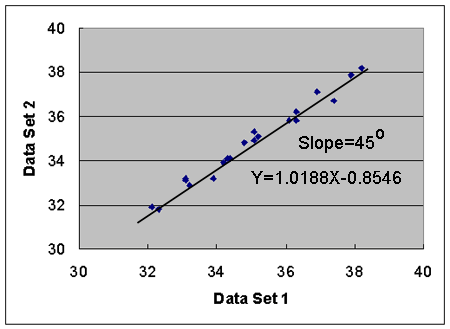-
the degree to
which the test yields the same results when given on two or more
different occasions or by the different examiners to the same
group of individuals
-
determined
statistically by correlation, t-tests, or
regressions
Using a regression
between the first and second measure, good reliability would exhibit
the following characteristics:
|
Subjects |
Data Set 1 |
Data Set 2 |
|
1 |
32.1 |
31.9 |
|
2 |
33.1 |
33.1 |
|
3 |
34.2 |
33.9 |
|
4 |
35.2 |
35.1 |
|
5 |
36.1 |
35.8 |
|
6 |
33.1 |
33.2 |
|
7 |
36.9 |
37.1 |
|
8 |
35.1 |
34.9 |
|
9 |
36.3 |
36.2 |
|
10 |
32.3 |
31.8 |
|
11 |
34.4 |
34.1 |
|
12 |
33.2 |
32.9 |
|
13 |
35.1 |
35.3 |
|
14 |
37.4 |
36.7 |
|
15 |
34.3 |
34.1 |
|
16 |
37.9 |
37.9 |
|
17 |
33.9 |
33.2 |
|
18 |
34.8 |
34.8 |
|
19 |
38.2 |
38.2 |
|
20 |
36.3 |
35.8 |
|
Mean |
34.995 |
34.8 |
Using the
expression y = mx + c for regression
1.slope of 45
degrees (slope = 1)
2.constant of zero
3.correlation
coefficient > 0.90 (?)
4.Significance
level? 0.01, 0.05?

|
Correlation |
Data Set 1 |
Data Set 2 |
|
Data Set 1 |
1.000000 |
0.990076 |
|
Data Set 2 |
0.990076 |
1.000000 |
|








